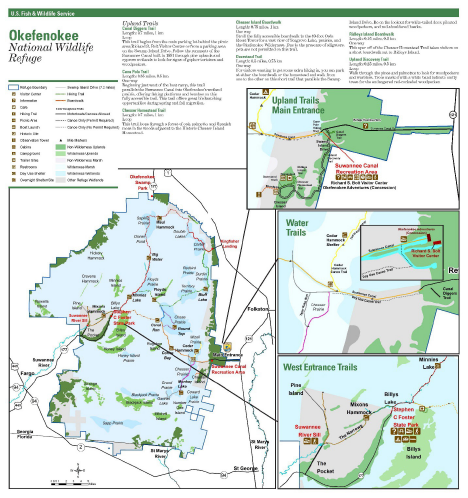Human History
Pottery and burial mounds indicate that humans have fished, hunted, gathered and lived within the swamp for at least 4,000 years, almost as long as the present incarnation of the swamp has been in existence. The original inhabitants regularly used fire to improve habitat and forage and to drive game to hunters. From 500 to 1000 AD, small villages populated the islands within the swamp. The transport of smallpox to North America by European explorers and colonists reduced the populations of original people in and around the swamp, and in the 1700s Spanish and English colonists killed or enslaved nearly all of the remaining Timucuan people who had inhabited the region. Seminoles, who were part of the larger Muscogee nation, used the swamp in the early 1800s as a place of refuge during the wars upon their tribe. By the 1830s, however, the Muscogee peoples of Georgia had been forcibly relocated to Oklahoma and elsewhere, and around that time white Americans and slave laborers began farming on the margins of the swamp.
In the 1850s, settlers moved onto Trail Ridge and some of the islands in the swamp where they raised livestock and bees, farmed, fished and hunted. These settlers did not have legal titles to the land, and in 1889 the State of Georgia sold the swamp to the Suwanee Canal Company, whose investors sought to drain the swamp. But after constructing 12 miles of canal, the group abandoned the project. By 1898, railroad lines encircled the swamp, creating opportunities for efficient extraction of timber. By 1900, the longleaf pine forests surrounding the swamp had been clearcut. The Hebard family of loggers purchased the swamp in 1901 and proceeded to harvest cypress trees from much of the swamp and pines from the islands. By the late 1920s, most of the accessible timber had been harvested.
During the logging period, scientists from Cornell University conducted biological surveys and advocated for federal protection for the swamp due to its biodiversity. In 1937, the federal government purchased the Okefenokee, and the administration of Franklin D. Roosevelt created the Okefenokee National Wildlife Refuge. From 1937-1941, the segregated Civilian Conservation Corps built facilities for the refuge, some of which are still in use today.
Many older Americans know the swamp through the popular Pogo Possum comic strip (AKA “Pogo”) written and drawn by Walt Kelly. Syndicated from 1948-1975. The animal characters of Pogo lived in the swamp but reflected political and cultural events in the United States.
The private non-profit Okefenokee Swamp Park on the north end of the swamp was established as a concession in 1946. The Stephen C. Foster State Park was developed in 1954 on Jones Island in the southwest corner of the swamp. Both parks provide access to their own walking trails and boardwalks, but also provide access to the Okefenokee National Wildlife Refuge which maintains a 120 mile water trail system, as well as its own system of trails and boardwalks
The above is mostly collated from the collected writings of historian Chris T. Trowell of South Georgia College.
Recreation & Tourism
Today, people come to the swamp to paddle, boat, go on guided boat tours, walk the trails, fish, learn about the animals and the ecosystem, practice nature photography, watch birds and other wildlife and enjoy the beauty of the dark night skies filled with stars. More than 725,000 visitors enter the swamp annually. Field trips to the swamp are highlights of the school year for many south Georgians.
There is one state park, one privately operated park, one National Wildlife Refuge and three boat launches that provide access to the Okefenokee swamp:
- Okefenokee National Wildlife Refuge Headquarters on the east side of the swamp near Folkston. Okefenokee National Wildlife Refuge | U.S. Fish & Wildlife Service (fws.gov)
- Okefenokee Swamp Park on the north side of the park near Waycross. Okefenokee Swamp Park provides day-use only. Home – Okefenokee Swamp Park & Adventures (okeswamp.org)
- Stephen C. Foster State Park on Floyd Island in the SW corner of the swamp, accessed from Fargo. The State Park has camping and cabins. Stephen C. Foster State Park | Department Of Natural Resources Division (gastateparks.org)
- Kingfisher Landing (boat launch and restrooms). Paddle Okefenokee – Kingfisher Landing.
- Suwannee River Sill (boat launch, bank fishing, and composting toilet). Explore Southern History – Suwannee Sill
- Boat launch at ONWR HQ near Folkston. Boat launch (fws.gov)
Each of these access points features boat launches, boat and canoe rentals, guided water tours of the swamp, hiking trails, and boardwalk trails. There are approximately 120 miles of water trails through the swamp, the water trail network can be access from Stephen C. Foster State Park, Kingfisher Landing, and the Okefenokee National Wildlife Refuge headquarters in Folkston. Note that a permit is required for the use of the camping platforms along the water trail system. With reservations, canoeists and kayakers can camp on floating docks within the swamp. Free-standing tents are required, as there is no ground in which to place stakes. Please visit the refuge website for more information about camping within the Refuge. There are also private and public campgrounds and cabin rentals around the periphery of the National Wildlife Refuge, as well as primitive camping areas on public lands.
Jon boats with motors can be rented from Stephen C. Foster State Park and Okefenokee Adventures at the Refuge headquarters in Folkston. About half of the trails are limited to non-motorized kayaks and canoes. All three main entrances provide guided tours on pontoon boats.

Check out this interactive map that shows many of the recreation features.
Quick Links
